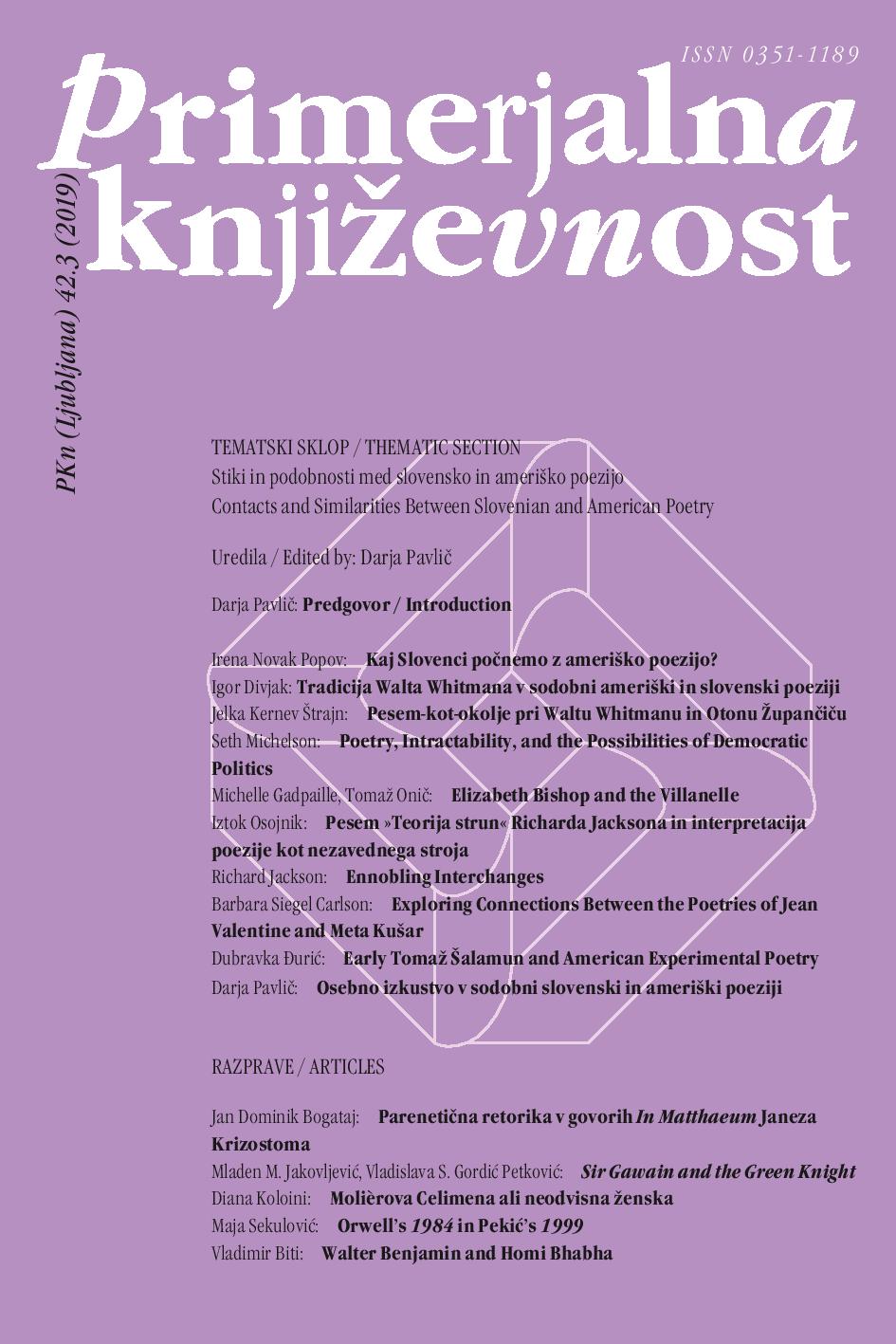Parenethic Rhetorics in the Orations In Matthaeum of John Chrysostom: Diatribe, Lalia, Protrepticus
DOI:
https://doi.org/10.3986/pkn.v42.i3.11Keywords:
Early Christian literature, Christian homiletics, Ioannes Chrysostomus, Commentarium in Matthaeum, classical rhetorics, rhetorical devices, exhortationAbstract
The article examines the relation between classical pagan and Christian rhetoric in the late antiquity through the case study of literary genres of moral exhortation in the homilies of John Chrysostom (347–407). First, it discusses the elements of diatribe, lalia and protrepticus as rhetorical forms of parenetical and counselling (psychogogical) character which were partly already known from the traditional classical Greek rhetoric and partly developed by the circles of late antique Hellenistic philosophers and theoreticians of rhetoric and style. The second aim of the article is to show in what measure these genres are present in the Chrysostom’s elocutio in the homilies In Matthaeum (Hom. 1, 7, 23). By doing this, the author presents some new insights on the influence of pagan rhetoric on Chrysostom, who uses some of the pagan literary forms to shape his moral exhortation, but he does this in an original style.References
a) Viri
Grillet, B., G. Sabbah, in J. Bidez, ur. Sozomène: Histoire ecclésiastique (livres VII–IX). SCh 516. Pariz: Éditions du Cerf.
Hicks, R. D., ur. Diogenes Laertius: Lives of Eminent Philosophers. Vol. 1. LCL 184. London; New York: W. Heinemann; Putnam, 1925.
Migne, J. P., ur. Chrysostomos, Ioannes. Homiliae XC in Matthaeum. Patrologia Graeca (PG) 57,1–472. Pariz: Imprimerie Catholique, 1862.
Russel, D. A., in N. G. Wilson, ur. Menander Rhetor. Oxford: Clarendon Press, 1981.
b) Literatura
Ameringer, Thomas E. The Stylistic Influence of the Second Sophistics on the Panegyrical Sermons of John Chrysostom: A Study in Greek Rhetoric. Washington: Catholic University of America, 1921.
Aristotel. Retorika. Prev. Matej Hriberšek. Ljubljana: Šola retorike Zupančič & Zupančič, 2011.
Baur, Chrysostomos. John Chrysostom and His Time. I in II. Maryland: The Newman Press, 1960.
Burns, M. A. St. John Chrysostom’s Homilies on the Statues: A Study of Their Rhetorical Qualities and Form. Washington: Catholic University of America, 1930.
Ciceron, Mark Tulij. O govorniku. Prev. Ksenija Geister. Ljubljana: Družina, 2002.
Cioffi, A. »L’eredità filosofica e retorica (diatriba e sentenza) nel Quod nemo laeditur nisi a seipso di Giovanni Crisostomo«. Nikolaus 6 (1978). 3–45.
Cook, James Daniel. Preaching and Popular Christianity: Reading the Sermons of John Chrysostom. Oxford: University Press, 2019.
Cribiore, Raffaella. Libanius the Sophist: Rhetoric, Reality, and Religion in the Fourth Century. Ithaca; London: Cornell University Press, 2013.
de Mendieta, Emmanuel Amand. »L’amplification d’un thème socratique et stoïcien dans l’avant-dernier traité de Jean Chrysostome«. Byzantion 36 (1966). 353–381.
Farrugia, Edward G. »John Chrysostom and the Preachability of the Word«. Melita Theologica 66.2 (2016). 33–45.
Fiore, Benjamin. »Parenesis and Protreptic«. The Anchor Bible Dictionary. 5. Ur. David Noel Freedman. New York: Doubleday, 1992. 162–165.
Hoof, Lieve van, ur. Libanius: A Critical Introduction. Cambridge: University Press, 2014.
Hriberšek, Matej. »Pregled antične retorike«. Izokrat, Lisija, Demosten, Ciceron, Evmenij: Antologija antičnega govorništva. Ur. Brane Senegačnik. Ljubljana: Študentska založba, 2001. 245–314.
Hubbel, Harry M. »Chrysostom and Rhetoric«. Classical Philology 19.3 (1924). 261–276.
Kelly, J. N. D. Golden Mouth: The Story of John Chrysostom – Ascetic, Preacher, Bishop. New York: Cornell University Press, 1995.
Kennedy, George Alexander. Greek Rhetoric Under Christian Empire. New Jersey: Princeton University Press, 1983.
Kennedy, George Alexander. Klasična retorika ter njena krščanska in posvetna tradicija od antike do sodobnosti. Prev. Nada Grošelj idr. Ljubljana: Založba ZRC, 2001.
Kinzig, Wolfram. »The Greek Christian Writers«. The Handbook of Classical Rhetoric in the Hellenistic Period. Ur. Stanley E. Porter. Leiden, Boston, Köln: Brill, 1987. 633–670.
Kvintilijan, Mark Fabij. Šola govorništva. Prev. Matjaž Babič. Ljubljana: Šola retorike Zupančič & Zupančič, 2015.
Malosse, Pierre-Louis. »Jean Chrysostome a-t-il été l’élève de Libanios?« Phoenix 62 (2008). 273–280.
Maxwell, Jaclyn L. Christianization and Communication in Late Antiquity: John Chrysostom and His Congregation in Antioch. Cambridge: University Press, 2006.
Mayer, Wendy, in Pauline Allen. John Chrysostom. New York; London: Routledge, 2000.
Mayer, Wendy. »John Chrysostom: Extraordinary Preacher, Ordinary Audience.« Preacher and His Audience: Studies in Early Christian and Byzantine Homiletics. Ur. Mary B. Cunningham in Pauline Allen. Leiden; Boston; Köln: Brill, 1998. 105–137.
Mitchell, Margaret Mary. The Heavenly Trumpet: John Chrysostom and the Art of Pauline Interpretation. Louisville; London: Westminster John Knox Press, 2002.
Rylaarsdam, David. John Chrysostom on Divine Pedagogy: The Coherence of His Theology and Preaching. Oxford: University Press, 2014.
Schatkin, Margaret Amy. John Chrysostom as Apologist. Thessaloniki: Vlatadon, 1987.
Starr, James, in Troels Engberg-Pedersen, ur. Early Christian Paraenesis in Context. Berlin: De Gruyter, 2004.
Uthemann, Karl-Heinz. »Forms of Communication in the Homilies of Severian of Gabala: A Contribution to the Reception of the Diatribe as a Method of Exposition«. Preacher and His Audience: Studies in Early Christian and Byzantine Homiletics. Ur. Mary B. Cunningham in Pauline Allen. Leiden; Boston; Köln: Brill, 1998. 129–177.
Willey, John Heston. Chrysostom: The Orator. Cincinnati; New York: Jennings and Graham; Eaton and Mains, 1906.


